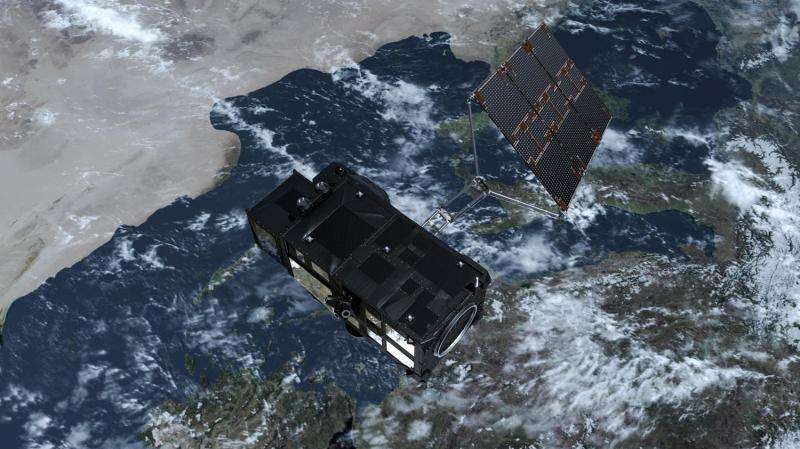Delivering Copernicus data with EUMETCast

Within months, EUMETSAT will begin disseminating the eagerly-awaited marine mission from Sentinel-3A, the latest addition to the EU's Copernicus fleet of earth observation satellites.
Following its successful launch and early operations phase, EUMETSAT has been supporting the European Space Agency (ESA) in-orbit commissioning activities, before EUMETSAT takes over routine operations of the spacecraft and processing data at its Sentinel-3 Marine Centre.
The Copernicus programme is Europe's response to the challenge of global environment monitoring and climate change.
Sentinel-3A will provide systematic measurements of the Earth's oceans, land, ice and atmosphere.
It has been described as "the most beautiful satellite ever built" from oceanographers' perspective, with its cutting-edge instruments' ability to provide highly accurate data on the ocean colour, sea surface temperature and sea surface height.
These data are crucial for Europe's 500 billion euro a year "blue economy" and will be relied upon by the fishing and aquaculture industries, coastal planners, the marine transport industry, environment and climate scientists and others, in addition to weather and ocean forecasters.
The EU has entrusted EUMETSAT to undertake, in cooperation with ESA, routine operations of Sentinel-3A, which was launched on 16 February and is now going through its commissioning phase, and to deliver its marine mission.
In addition, EUMETSAT will deliver to Copernicus data from the joint European-US Jason-3 ocean altimetry satellite, which was launched in January this year, as part of an integrated marine data stream, incorporating data from third-party missions of our partners in the US, China and India.
Jason-3 will expand until 2021 the unique mean sea-level climate data record, started in 1992 by Topex-Poseidon, and continue to provide the reference ocean surface topography measurements used for cross-calibrating all other altimeter missions, including Sentinel-3, and this data will also soon be available.
Sentinel-3A has already delivered impressive first images from its Ocean and Land Colour Instrument, altimeter and Sea and Land Surface Temperature Radiometer and the quality of the products is expected to improve with fine-tuning over the remaining months of the commissioning before EUMETSAT begins routine operations.
When Sentinel-3A's marine mission is fully operational, these new, advanced instruments will be sending back to Earth high quality data in vastly increased amounts.
EUMETSAT offers users and service providers access to a multi-mission data stream via EUMETCast, a highly-reliable, cost-effective system based on off-the-shelf, commercially available, standard Digital Video Broadcast technology.
EUMETCast's highly scalable architecture will provide the near real-time Sentinel-3 data services to an unlimited number of simultaneous users, regardless of the possible limitations of local communication infrastructures.
The UK-based European Centre for Medium-range Weather Forecasts (ECMWF), which produces and disseminates numerical weather predictions to its 34 Member States and is both a research institute and operational service, receives more than 50 gigabytes of data via EUMETCast in near real time every day.
"EUMETCast delivers the majority of the satellite observations operationally assimilated at ECMWF," ECMWF Head of Evaluation Section David Richardson said.
"These are important to the quality of the forecasts in all regions and in those parts of the world where non-satellite observations are scarce the forecast skill would fall dramatically without the observations disseminated by EUMETCast.
"EUMETCast provides a very reliable, cost-effective and easy to use mechanism for the near real time delivery of more than 50 gigabytes of satellite data every day. It is an essential component of ECMWF's data reception system.
"ECMWF is also making use of the EUMETCast service to broadcast essential weather forecast products to over 50 African countries overcoming the lack of network infrastructure available in this area of the world."
"The addition of Sentinel-3A data will complement the already existing marine data stream we have available on EUMETCast"
EUMETSAT User Relations Manager Sally Wannop said: "As a single data access mechanism, EUMETCast is the one-stop-shop to a wide range of environmental data.
"The addition of Sentinel-3A data will complement the already existing marine data stream we have available on EUMETCast."
In addition, EUMETSAT will disseminate the Sentinel-3A data on-line, via itsCopernicus Online Data Access, and to international partners via EUMETCast Terrestrial, which functions like the satellite service but using a terrestrial network instead.
The DVB satellite link is replaced by a connection to a national research network. EUMETCast Terrestrial has the potential to reach users beyond the EUMETCast satellite footprint, for example, in Australia.
EUMETSAT is already looking at future evolutions of its data services to users.
A series of pathfinder projects, involving hosted processing, new data view capabilities, the creation of a format conversation toolbox and online data platforms, for example, are currently being undertaken.
Many of the enhancements arising from these projects will also be applied to the Copernicus data.
Provided by European Organisation for the Exploitation of Meteorological Satellites (EUMETSAT)


















